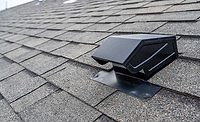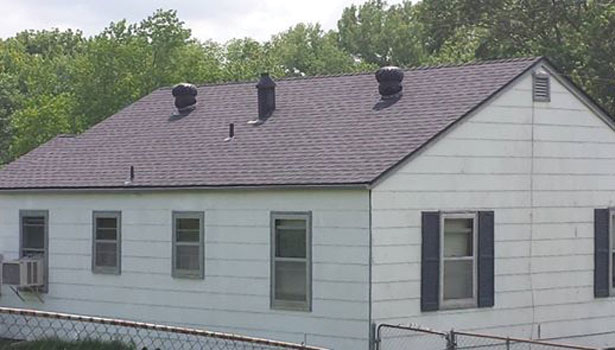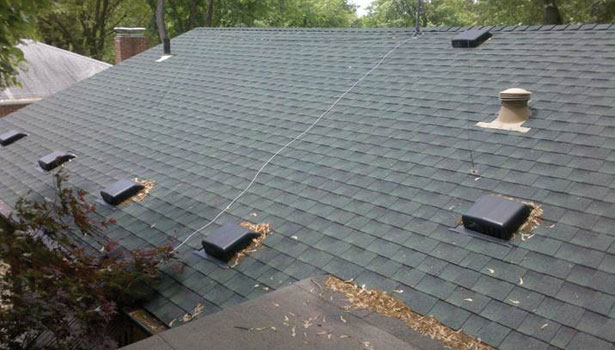Attic Ventilation Mistakes Caught on Camera

Mistake No. 1 : Bagging wind turbines in the winter.
The Fix: Unbag them so they can work year-round, including helping to fight the 2-4 gallons of water vapor house occupants generate daily in the winter.
Photo courtesy of Shawn Bellis, Epic Exteriors, Overland Park, Kan.

Mistake No. 2: Mixing two or more different types of exhaust vents on the same roof above a common attic.
Photo courtesy of Anthony Davis, All Sound Roofing Inc., Arlington, Wash.

Photo courtesy of Jake Jacobson, SF5 Construction, Little Elm, Texas.

Photo courtesy of Nate Speers, Atlanta Re-Roof Specialists, Roswell, Georgia.

Photo courtesy of Tommy Coleman, P J Fitzpatrick Inc., Wilmington, Del

The Fix: Don’t mix any two different types of exhaust vents (ridge vents, power fans, wind turbines, roof louvers or gable louvers) so as to avoid short-circuiting the attic ventilation system. Short-circuiting reduces the efficiency of the system and could result in weather infiltration.
Photo courtesy of Jason Avery, Lakefront Roofing and Exteriors, Covert, Mich.

Mistake No. 3: Using exhaust vents low on the roof as intake vents.
Photo courtesy of Dustin Bassi, A & D Exteriors, Bartlett, Ill.

The Fix: Keep exhaust vents high on the roof where they were designed to be; install soffit, undereave or edge-of-roof style intake vents. Using exhaust vents as intake vents increases the chance of a roof leak and weather infiltration because they are designed to be 2-3 feet from the peak of the roof.
Photo courtesy of Sue May, A Better Way Roofing, Lincoln, Neb.

Mistake No. 4: Incorrectly matching the vent to the house’s architectural design.
Photo courtesy of J. R. Lynch, Elbert Construction, Noblesville, Ind.

The Fix: Roofs with generous ridge lines are perfect candidates for ridge vents, NOT individual roof louvers. Cut-up roofs are ideal for power fans or hip ridge vents. Select the vent that best meets the roof’s design.
Photo courtesy of Stan Robinson, Pacific West Roofing LLC, Tualatin, Ore.

Mistake No. 5: Cutting the wrong size hole for the vent.
Photo courtesy of Shawn Bellis, Epic Exteriors, Overland Park, Kan.

Photo courtesy of Sean Toms, S & K Roofing, Eldersburg, Md.

The Fix: Cut the vent hole according to the manufacturer’s installation requirements to maximize the vent’s Net Free Area and to provide the attic with necessary airflow.
Photo courtesy of Ron Bastian, Bastian Roofing, Richfield, Wis.













One of the most popular portions of Air Vent’s annual educational seminars for roofing professionals – Attic Ventilation: Ask the Expert™ – is installation tips. Contractors in particular have been very generous sharing tried and tested tips to help other roofers when installing residential attic ventilation products. They genuinely have best practices in mind when sharing this information. They also uncover mistakes made in the field — many times mistakes they are paid to fix.
Here are some of our favorite photos from Air Vent seminar attendees and Facebook friends documenting problems they’ve uncovered in the field. Some photos show multiple mistakes but were chosen to highlight one. We’re always looking for more. Please keep them coming.
Click the pictures for an enlarged version.

|
Mistake No. 1: Bagging wind turbines in the winter.
The Fix: Unbag them so they can work year-round, including helping to fight the 2-4 gallons of water vapor house occupants generate daily in the winter.
Photo courtesy of Shawn Bellis, Epic Exteriors, Overland Park, Kan.

|

|

|

|

|
Mistake No. 2: Mixing two or more different types of exhaust vents on the same roof above a common attic.
The Fix: Don’t mix any two different types of exhaust vents (ridge vents, power fans, wind turbines, roof louvers or gable louvers) so as to avoid short-circuiting the attic ventilation system. Short-circuiting reduces the efficiency of the system and could result in weather infiltration.
Photo courtesy of Anthony Davis, All Sound Roofing Inc., Arlington, Wash.
Photo courtesy of Jake Jacobson, SF5 Construction, Little Elm, Texas.
Photo courtesy of Nate Speers, Atlanta Re-Roof Specialists, Roswell, Ga.
Photo courtesy of Tommy Coleman, P J Fitzpatrick Inc., Wilmington, Del.
Photo courtesy of Jason Avery, Lakefront Roofing and Exteriors, Covert, Mich.

|

|
Mistake No. 3: Using exhaust vents low on the roof as intake vents.
The Fix: Keep exhaust vents high on the roof where they were designed to be; install soffit, undereave or edge-of-roof style intake vents. Using exhaust vents as intake vents increases the chance of a roof leak and weather infiltration because they are designed to be 2-3 feet from the peak of the roof.
Photo courtesy of Dustin Bassi, A & D Exteriors, Bartlett, Ill.
Photo courtesy of Sue May, A Better Way Roofing, Lincoln, Neb.

|

|
Mistake No. 4: Incorrectly matching the vent to the house’s architectural design.
The Fix: Roofs with generous ridge lines are perfect candidates for ridge vents, NOT individual roof louvers. Cut-up roofs are ideal for power fans or hip ridge vents. Select the vent that best meets the roof’s design.
Photo courtesy of J. R. Lynch, Elbert Construction, Noblesville, Ind.
Photo courtesy of Stan Robinson, Pacific West Roofing LLC, Tualatin, Ore.

|

|

|
Mistake No. 5: Cutting the wrong size hole for the vent.
The Fix: Cut the vent hole according to the manufacturer’s installation requirements to maximize the vent’s Net Free Area and to provide the attic with necessary airflow.
Photo courtesy of Shawn Bellis, Epic Exteriors, Overland Park, Kan.
Photo courtesy of Sean Toms, S & K Roofing, Eldersburg, Md.
Photo courtesy of Ron Bastian, Bastian Roofing, Richfield, Wis.
Looking for a reprint of this article?
From high-res PDFs to custom plaques, order your copy today!



















